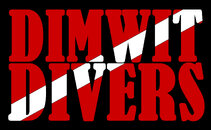A Diving Primer for DIMWITs (Rev. 1)
There has been a recent surge in the popularity of DIMWIT diving and with it, demonstration of lack of understanding of what it truly means to be a DIMWIT. My intent here is to provide a brief overview of DIMWIT diving, hit a few of the more important guidelines and provide guidance to those of you that would like to pursue excellence in the DIMWIT field.
Overview
There is a bit of controversy on the actual meaning of DIMWIT. DIMWIT is an acronym that stands for Doing It My Way In Texas. Others have other meanings but it is dependent upon them to write their own damn manual. This manual is about Doing It My Way. And by My Way I dont mean my way. The beauty of the true DIMWIT system is that each individual thinks through their own particular circumstances and dive plans and creates their own well thought out system for dealing with the challenges thereof. Its a holistic system that must be achieved through honest self evaluation and problem solving techniques. It is a system that celebrates the freedom and ultimate responsibility of the individual.
Guidelines
The DIMWIT diver doesnt deal in absolute rules as that would not foster the premise of Doing It My Way. Rather, guidelines are provided to help the DIMWIT in their personal dive development. Please realize that there is no place in the DIMWIT system for dimwits. They will eliminate themselves according to the concepts that Charles Darwin, an early DIMWIT advocate, developed in the mid-19th century. Some guidelines to assist you in your development include:
- Never dive with someone that cant think for him/herself.
- The corollary to guideline #1: If another diver is thinking for him/herself but its not something you might think for yourself in similar circumstances, you may politely withdraw from participation but remain close and be prepared to render aid in the event that the idea turns out to have a less desirable outcome than originally envisioned.
- Never be the other diver mentioned in guideline #2.
- Refrain from using gardening implements as life support equipment.
- Always carry a knife that is at least big enough to kill a poisonous water snake if necessary. (If you feel that sawing a water moccasin in half is best done with a one inch long broken steak knife, then you are a better man than I, Gunga Din)
- Duct tape is the preferred method for repairing all buoyancy compensators, drysuits, wetsuits, lift bags, LP hoses and broken mask straps.
- Zip ties are the preferred method for repairing anything that is not covered under #6 including brake caliper repair.
- Any gear that cannot be repaired with duct tape or zip ties probably doesnt belong on a DIMWIT.
- If at least 50% of a particular gear configuration can be acquired at a Feed Store, it is permissible to refer to that diving style as Tack Diving.
- Gear should be configured based on the divers personal preference developed through a vigorous process of problem analysis and solution. Other divers may or may not understand your reasoning, but that is their problem. After all, you know that they are secretly jealous of your creative genius.
- Never criticize another divers gear configuration. They may secretly be a creative genius. (If you feel that their gear configuration will place you in some jeopardy, please see guideline #2)
- Always ask for permission from the property owner prior to diving in a stock tank. If this is not possible because you and the owner have had numerous past confrontations, then you should park at least 1/2 mile away and quietly hike in under the cover of darkness. Dive lights are discouraged for obvious reasons. Please observe guideline #5.
- When diving in stock tanks, be sure the resident bull is securely penned elsewhere on the property.
- When spearfishing in stock tanks it is considered good form to clean and provide some of your catch to the owner of the tank.
- When spearfishing in stock tanks it is considered bad form to spear your buddy because he looked like a state record yellow cat in all the murk. It is even worse form to then clean and provide part of your catch to the owner of the tank.
- It is not considered polite to wear neoprene exposure protection when diving stock tanks. Drysuits could be considered downright rude and may result in being invited to leave the property at the barrel of a 12 gauge.
- The proper attire for diving stock tanks from May-October is cut-off jeans. During November-April, use your old Sunday go-to-meeting pants that now have a hole in the seat. International Orange is strongly suggested for all back country wear during hunting season whether diving or not.
- When diving the Devils River, dont stand or kneel on the bottom while performing skills or you may be shot at by the adjacent landowner for trespassing.
- Given the choice between clear, warm blue water with unlimited visibility and green murky water of dubious quality, dont be a dimwit. Dive the clear blue water.
A number of these guidelines could be expanded into whole areas of study such as the use of duct tape. New guidelines can be developed to address other areas of need such as diving in bar ditches. I dont personally have extensive experience dealing with such challenges and thus am not the best person to develop a DIMWIT system to address them. If you, dear reader, have such experience then please step up and assist your fellow DIMWITs.
Please realize that the DIMWIT system is a living breathing thing that is in a constant state of change. I know of a certain diver in Paris that is meeting the challenges of DIMWIT diving head on and on a daily basis. If we were all so diligent in our works we could change the face of diving as we know it!
Identification
One way to identify a fellow DIMWIT is by the use of the secret handshake. Unfortunately, since all DIMWITs do the handshake their own way, it is difficult to ascertain if someone is giving you the real DIMWIT shake or some bogus knockoff. The only reliable way to identify a fellow DIMWIT is through observation of known or suspected DIMWIT diving techniques and gear configurations.
Certification
There is no such thing as a certified DIMWIT. The process of certification, by its very nature, begs the question How?. As in How can you certify whether I am doing it My Way?. Therefore certification is impossible as there are no qualified certifiers.
Likewise, there are no specialties. Each dive and each diver are unique. The DIMWIT diver must constantly ask him/herself What must I do to complete THIS dive? Some people argue that the DIMWIT method just involves common sense and the conscientious decision to either exercise it or not. The main problem with this argument is that it assumes that common sense is, in fact, common. We DIMWITs recognize how uncommon common sense is and either exercise it, or not, when planning each dive. In a way it can be comparable to performance art. Except without the art. And sometimes without the performance. (please see guideline #2)
If it is important to you as a thinking, problem solving diver to own badges or tiaras, and feel it will assist you in being a better DIMWIT, then feel free to develop what you think the appropriate form of recognition should be. Also feel free to call yourself certified in DIMWITicism if it furthers your own needs and development. No true DIMWIT would want to hold you back as an individual just because of semantics, although we may invoke guideline #2 at some point.
Please note that although it is theoretically possible to achieve DIMWITicism in Tibet, Thailand, Taipei, Trafalgar Square, Teotihuacan, Tokyo or the Trevi Fountain, you may get some funny looks. In Texas, any onlooker will assume you are just scrubbing the bottom of your bass boat.
The preferred method of achieving DIMWITicism includes a trip to Texas. The benefit of this method is that it would allow someone to double up and get his/her Texas Swamp Diver certification at the same time. Two for the price of one, and youd have to be a dimwit to not take advantage of that!





 I must say I like your pony bottle much better than mine. Can you get it in a 40? I really don't think mounting it would be a problem. BTW something tells me you guys don't need any info on the use of it either.
I must say I like your pony bottle much better than mine. Can you get it in a 40? I really don't think mounting it would be a problem. BTW something tells me you guys don't need any info on the use of it either. 

